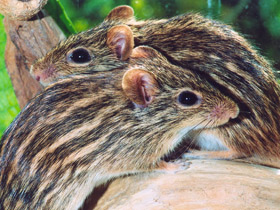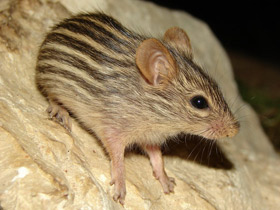The typical striped grass mouse (Lemniscomys striatus)
Description, habitat, diet, reproduction
The typical striped grass mouse (Lemniscomys striatus) is a small rodent inhabiting Africa: its body length is from 10 to 14 cm and its weight is 42.3 g on average. The colouration of this mouse is amazing: intermittent light stripes on the dark background of its back and sides.
Lemniscomys striatus feeds mainly on plant food: mainly fruits, root crops, soft seeds, sometimes eating insects.
The female reaches sexual maturity at the age of 168 days, the gestation period is approximately twenty-five days, and the litter contains 2 to 5 cubs.
In the wild, they do not survive at all after their first breeding period. In captivity, they can live longer. The maximum age recorded in captivity is 4.8 years.
Taxonomy
Lemniscomys striatus comprises a complex of various similar species. Furthermore, there are about eleven different species of striped grass mouse, of which Lemniscomys barbarus and Lemniscomys striatus are the two most frequently encountered in captivity.
The species is divided into the following six subspecies:
- Lemniscomys striatus striatus: Guinea Bissau, Guinea, Mali, Burkina Faso, Sierra Leone, Liberia, Ivory Coast, Ghana, Togo, Benin, Nigeria, Cameroon, Central African Republic, DRCongo;
- Lemniscomys striatus ardens (Thomas, 1910): central Kenya and southern Tanzania;
- Lemniscomys striatus dieterleni (Van der Straeten, 1976): eastern DRCongo;
- Lemniscomys striatus luluae (Matschie, 1926): Angola, southern DRCongo;
- Lemniscomys striatus massaicus (Pagenstecher, 1885): South Sudan, Uganda, Tanzania, Ruanda, Burundi, Zambia and southeastern DRCongo;
- Lemniscomys striatus wroughtoni (Thomas, 1910): central and western Ethiopia.











































